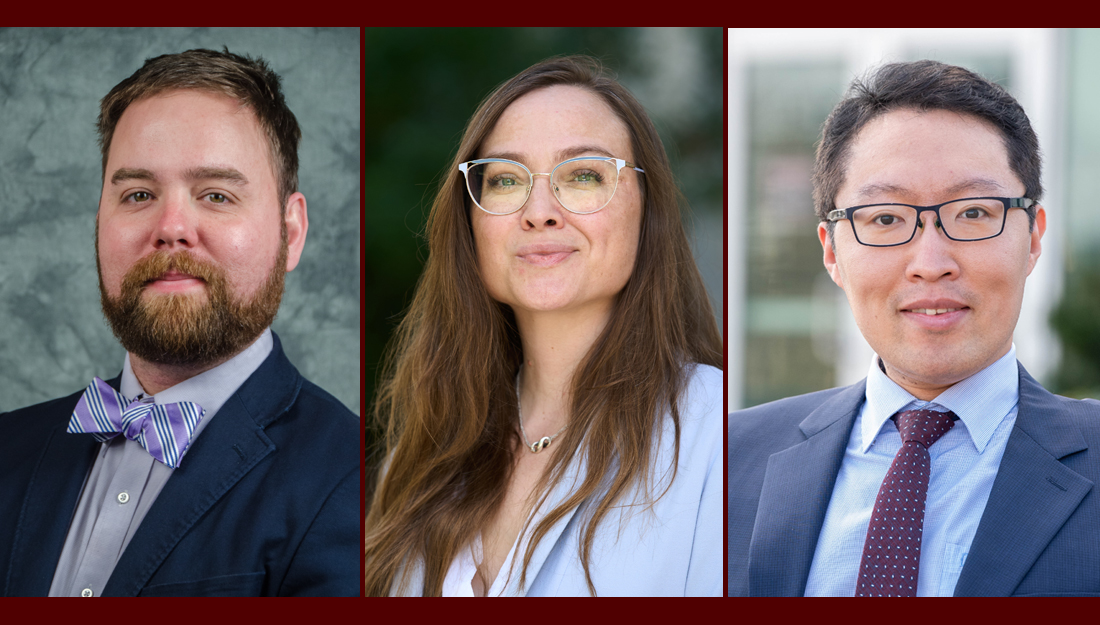- Methodist Healthcare Ministries and School of Public Health staff
- Community, Community Impact, Public Health, Show on VR homepage
Methodist Healthcare Ministries awards School of Public Health $5 million to continue South Texas Safe Water Project
Four-year extension expands project to neighboring South Texas counties

Garett Sansom, Lindsay Sansom and Taehyun Roh will lead Texas A&M’s contributions to restore clean water and improve well-being in underserved South Texas communities.
Methodist Healthcare Ministries of South Texas, Inc. (MHM) announced it will continue partnering with the Texas A&M University School of Public Health on the South Texas Safe Water Project through 2028. The $5 million, four-year grant will enable the School of Public Health to further identify sustainable solutions for critical water quality and public health challenges in the underserved Cameron, Hidalgo, Starr and Willacy counties in South Texas. The funding was announced at a community presentation held at the Texas A&M Higher Education Center at McAllen.
“Our work with Texas A&M on the South Texas Safe Water Project is only just getting started as we plan to use the data from this first phase to inform public policy and expand our partnership into other communities,” said Jaime Wesolowski, president and CEO of Methodist Healthcare Ministries. “We want to dig deeper, literally, by also taking soil samples to examine the full depth of this crisis. The health outcomes and outlook for those we serve shouldn’t be limited by the water they drink. We are committed to learning more and supporting policies and innovative solutions that restore clean water and improve well-being for all.”
The South Texas Safe Water Project will continue to be led by School of Public Health researchers Garett Sansom, DrPH, and Taehyun Roh, PhD, as the principal investigators, along with co-investigator Lindsay Sansom, PhD. The project continues the work that began with dual, two-year pilot studies conducted by Texas A&M researchers in collaboration with MHM announced in 2022.
The first project assessed the exposure to arsenic and other heavy metals from drinking water sources in residents of colonias along the Rio Grande border and implemented interventions to reduce it. The second project introduced community-based participatory research concepts to high school students in the region.
“The new, four-year project will build on the success of our collaboration with Methodist Healthcare Ministries to provide sustainable solutions for improving water quality, strengthen community resilience and foster long-term, positive health outcomes,” Garett Sansom said.
High levels of heavy metals found in colonia residents’ drinking water
The 2022-2024 study revealed significant heavy metals in colonia residents’ drinking water. The researchers found uranium, nickel and arsenic in 100 percent of the potable water samples taken from 203 homes in the studied colonias. They also found evidence of long-term arsenic exposure in all the participants’ toenail and urine samples and vitamin deficiencies associated with exposure in one third of the participants.
“Water is a particular concern in the colonias because arsenic is prevalent along the South Texas border with Mexico and because most residents get their water from systems that are old, poorly maintained and may not meet state or federal standards for drinking water,” Roh said.
Heavy metals, such as lead, mercury and arsenic, are found naturally in soil and water in many regions of the United States. High levels of most heavy metals, however, are associated with major health problems, including cancer, cognitive issues and developmental delays. Children and pregnant women face the highest risk.
Engaging local stakeholders at every stage
To address water quality and other health issues, the researchers used a community-based participatory research model to ensure collaboration with colonia residents and other local stakeholders at every stage, from determining the research priorities to disseminating the findings. This was achieved through input and advice from three community advisory boards with 60 members including promotoras—community members who receive specialized health-related training—nonprofit leaders and residents.
“The concerns that the community members shared with us helped to determine the research process and also built trust between everyone involved,” Lindsay Sansom said. “Strong community engagement and established trust led to high rates of resident participation: more than 96 percent on survey completion and more than 80 percent in collecting urine and toenail samples for heavy metals testing.”
Local teens become “citizen scientists”
The second pilot study involved working 1:1 to help 14 high school-aged students become “citizen scientists” with a deep understanding of the water quality problems in their communities and how to pursue possible remedies through research and environmental justice advocacy.
“It’s not enough for us to simply tell the people who live there about what we’re doing,” Garett Sansom said. “This effort will make a long-term difference only to the extent that those who live with these environmental challenges understand all aspects of what’s going on with their water—and why—and also are empowered to seek and implement improvements.”
In addition to learning about where contaminants such as lead and arsenic come from and how they affect the health of those in their communities, the students were trained in water sampling techniques. At the end of the program, the students received Citizen Science Certificates in a graduation ceremony at the Texas A&M McAllen campus.
“The student participants reported that not only were they satisfied with what they learned, but the experience also increased their likelihood to pursue higher education,” Lindsay Sansom said. “This example offers a model of sustainability for continued engagement and advocacy by residents of all ages—while inspiring some to pursue careers in STEM fields.”
Building on a foundation of research and advocacy
The South Texas Safe Water Project installed more than 400 water filters in the colonias, leading to a 63 percent reduction of arsenic by the pilot study’s end. These promising results led colonia residents, state and local government officials, public health experts and academic researchers to participate in a two-day workshop in San Antonio in October 2024. There, they focused on water quality issues and other public health risks and identified policy solutions, programmatic interventions and areas where additional research might be required.
“The policy recommendations prescribed as a result of this study will be a powerful tool that our policy and advocacy team can use to push for change during the 89th Texas Legislative Session,” said Christine Yanas, vice president of policy and advocacy for MHM. “Having the data to strengthen the case for action will solidify the support from state policymakers to drive impactful changes at the local level.”
Now, the additional grant funding will enable the Texas A&M-MHM collaboration to build on and expand their previous efforts. The three overarching goals are to identify and address water quality and other environmental hazards by working directly with policymakers, to empower more community members to act on these issues and to use cutting-edge research methods to drive further collaboration.
“We believe this critical investment will not only advance the long-term health and well-being of people in South Texas but also will provide a scalable model that could benefit people in similarly underserved regions,” Roh said.
Media contact: media@tamu.edu


